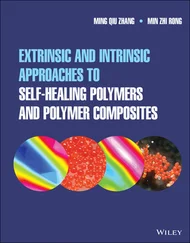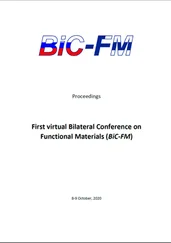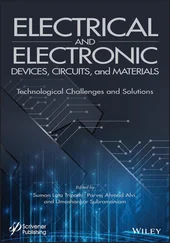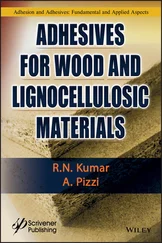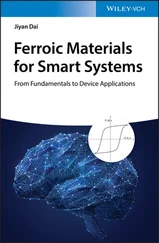Self-Healing Smart Materials
Здесь есть возможность читать онлайн «Self-Healing Smart Materials» — ознакомительный отрывок электронной книги совершенно бесплатно, а после прочтения отрывка купить полную версию. В некоторых случаях можно слушать аудио, скачать через торрент в формате fb2 и присутствует краткое содержание. Жанр: unrecognised, на английском языке. Описание произведения, (предисловие) а так же отзывы посетителей доступны на портале библиотеки ЛибКат.
- Название:Self-Healing Smart Materials
- Автор:
- Жанр:
- Год:неизвестен
- ISBN:нет данных
- Рейтинг книги:4 / 5. Голосов: 1
-
Избранное:Добавить в избранное
- Отзывы:
-
Ваша оценка:
- 80
- 1
- 2
- 3
- 4
- 5
Self-Healing Smart Materials: краткое содержание, описание и аннотация
Предлагаем к чтению аннотацию, описание, краткое содержание или предисловие (зависит от того, что написал сам автор книги «Self-Healing Smart Materials»). Если вы не нашли необходимую информацию о книге — напишите в комментариях, мы постараемся отыскать её.
Self-Healing Smart Materials — читать онлайн ознакомительный отрывок
Ниже представлен текст книги, разбитый по страницам. Система сохранения места последней прочитанной страницы, позволяет с удобством читать онлайн бесплатно книгу «Self-Healing Smart Materials», без необходимости каждый раз заново искать на чём Вы остановились. Поставьте закладку, и сможете в любой момент перейти на страницу, на которой закончили чтение.
Интервал:
Закладка:
Chapter 6focuses on an ideal and long-lasting photovoltaic device which can heal all of the damages applied to its structure to decrease maintenance costs of solar panels. The current self-healing mechanisms and recent progress in solar cells are summarized.
Chapter 7provides additional insights into the construction of self‐ healable core-shell nanofiber agents and their potential application in various areas.
Chapter 8details the state-of-the-art in intrinsic self-healing smart materials. It summarizes some of the most significant research on SHSMs.
Future challenges that need to be overcome to enable commercial exploration of systems already developed are also discussed.
Chapter 9discusses self-healable materials in the field of catalysis. The basics and application areas of catalysts that are reported in the literature are covered. Additionally, some specific energy fields, such as oxygen evolution and hydrogen generation catalysts, are discussed in detail.
Chapter 10details the recent advances regarding the potential applications of various types of micro/nano-carriers of healing agents for the development of smart/intrinsic self-healing anti-corrosion polymeric coatings. The SHSMs/fillers classification, various techniques used to load inhibitors into carriers/containers, and their release/corrosion-inhibition mechanisms are introduced and conceptualized.
Chapter 11discusses the various methods of self-healing for conductive materials. Self-healing conductive materials, such as elastomers, reversible bonds, polymers, capsules, liquids and composite, are discussed. The complex conductivity which can be established even as a coating is also discussed.
Chapter 12deals with the preparation and properties of self-healable electronic skin. Its various applications as a pressure sensor and body motion sensor are discussed. Artificial skin can also be used for electrocardiogram and electromyograph monitoring, as well as for monitoring Parkinson’s tremor.
Chapter 13overviews self-healing smart composite materials and their different self-healing mechanisms. These materials are designed based on two approaches: (a) discharge of smart self-healing agents towards the generated damage and (b) alterable crosslinking networks.
Chapter 14overviews the stimuli-responsive self-healable materials. It provides details about the history, different types and importance of self-healable materials. The major focus is on recent examples of self-healing polymers that show response to various stimuli. The chapter ends with a discussion about aspects concerning the commercialization of SHSMs and challenges in the area.
Chapter 15covers mechanically-induced SHSMs with novel characteristics for numerous applications. Various methods of producing these mechanically-induced SHSMs based on different types of materials are discussed.
Chapter 16discusses SHSMs, their method of synthesis, and application in robotics. The focus of the chapter is on describing the chemistry of self-healing and the working principles. The various approaches of self-healing are also explained such as capsule-based, vascular, and intrinsic self-healing systems. The major focus is on the application of the material in the different sections of soft robots such as skin, actuator, electronics, and sensor.
Chapter 17discusses the various methods of developing SHSMs for aerospace structural and high-temperature applications. Materials like fiber-reinforced polymers that alter the nature of the base matrix and ceramic matrix composites are described in detail along with intrinsic and extrinsic self-healing mechanisms.
Chapter 18presents bioinspired, magnificent, nature-based, broadscope elements with numerous functions. These elements exhibit immense power to perceive, respond, and self-heal (autonomous healing). The discussion proceeds with a brief insight into SHSMs, coatings, their types, and the exploitation process used to extract their characteristic features to benefit humankind. This chapter sheds more light on examples dealing with self-healable materials with a notion to fabricate such self-healable materials with rapid exploration and a promising platform.
Chapter 19introduces SHSMs as promising candidates for the fabrication of electronic devices, energy storage systems, and even sensors. The progress made in SHSMs research is detailed and the preparation mechanisms and properties of the self-healing processes are summarized. In terms of self-healing batteries, both macroscopic and microscopic SHSMs are introduced.
Chapter 20focuses on self-healing in bleeding engineered composite structures. Additionally, materials with intrinsic and extrinsic self-healing properties are discussed. Moreover, various strategies like bioinspired, biomimetic and vascular networks, are described in detail. Also discussed are approaches for the synthesis of bleeding composite structures, along with their evolved properties, repairing mechanism, disadvantages, and advantages.
Chapter 21provides a general overview of numerous materials with self-healing attributes. Greater emphasis is also placed on autonomic and non-autonomic types of SHSMs. The mechanism of action of these SHSMs are also highlighted.
Inamuddin, Mohd Imran Ahamed, Rajender Boddula and Tariq Altalhi
March 2021
1
Self-Healing Polymer Coatings
Facundo I. Altuna* and Cristina E. Hoppe †
Instituto de Investigaciones en Ciencia y Tecnología de Materiales (INTEMA), Universidad Nacional de Mar del Plata—CONICET, Mar del Plata, Argentina
Abstract
Traditional coatings made of thermosetting polymers could not be healed or mended because of their cross-linked structure, so damage implied the end of their service life cycle. This picture has dramatically changed since the first self-healing systems reports, moment in which this “disadvantage” of thermosets has started to vanish with the continuous increase in the availability of self-healing and recyclable thermosetting polymers. These advances constitute a breakthrough, as they would avoid replacement and catastrophic failure, encourage recycling and re-processing and prevent the generation of a considerable amount of waste, with obvious environmental and economic benefits. This chapter describes some of the more recent advances in the field of self-healing thermosetting polymers with potential application as coatings. Extrinsic self-healing thermosets use an external agent to perform the healing whereas intrinsic ones require the intervention of an external trigger for repair damage. The first part of the chapter describes the work in extrinsic self-healing thermosets, and the second part in intrinsic ones, with emphasis on polymeric networks with dynamic covalent bonds (DCBs). The most common strategies for the external triggering of intrinsic self-healing polymers are also described. Finally, challenges are discussed with the aim put in attaining the so expected end-user applications.
Keywords :Self-healing, thermosets, dynamic covalent bonds (DCBs), coatings, crosslinked polymers
1.1 Introduction
Traditionally, materials science and technology research has been a quest for improving one or several properties of any given class of materials, so that they can have an enhanced performance. With this aim, all kinds of materials from ceramics and metals to glasses and soft polymers are nowadays designed based on strong scientific knowledge. However, during their service life, materials can suffer damages with consequences that range from affecting the way in which the materials are supposed to work to catastrophically break down or, in the case of a damaged coating, leaving the substrate deprived from its protection. In such cases, besides all the relevant physicochemical, mechanical, thermal and other properties, it would be highly desirable that the material could be mended. Doing so, it would avoid its replacement and save lots of time and economic resources. It would also prevent the generation of a considerable amount of waste, with obvious environmental and economic benefits. With this purpose, the development of self-healing polymers is gaining momentum since the first works studying healing mechanisms in polymers were published about 40 years ago [1, 2]. Another leap forward followed with the design of self-healing polymeric systems containing vessels with healing agents [3, 4], which demonstrated autonomous healing ability.
Читать дальшеИнтервал:
Закладка:
Похожие книги на «Self-Healing Smart Materials»
Представляем Вашему вниманию похожие книги на «Self-Healing Smart Materials» списком для выбора. Мы отобрали схожую по названию и смыслу литературу в надежде предоставить читателям больше вариантов отыскать новые, интересные, ещё непрочитанные произведения.
Обсуждение, отзывы о книге «Self-Healing Smart Materials» и просто собственные мнения читателей. Оставьте ваши комментарии, напишите, что Вы думаете о произведении, его смысле или главных героях. Укажите что конкретно понравилось, а что нет, и почему Вы так считаете.


